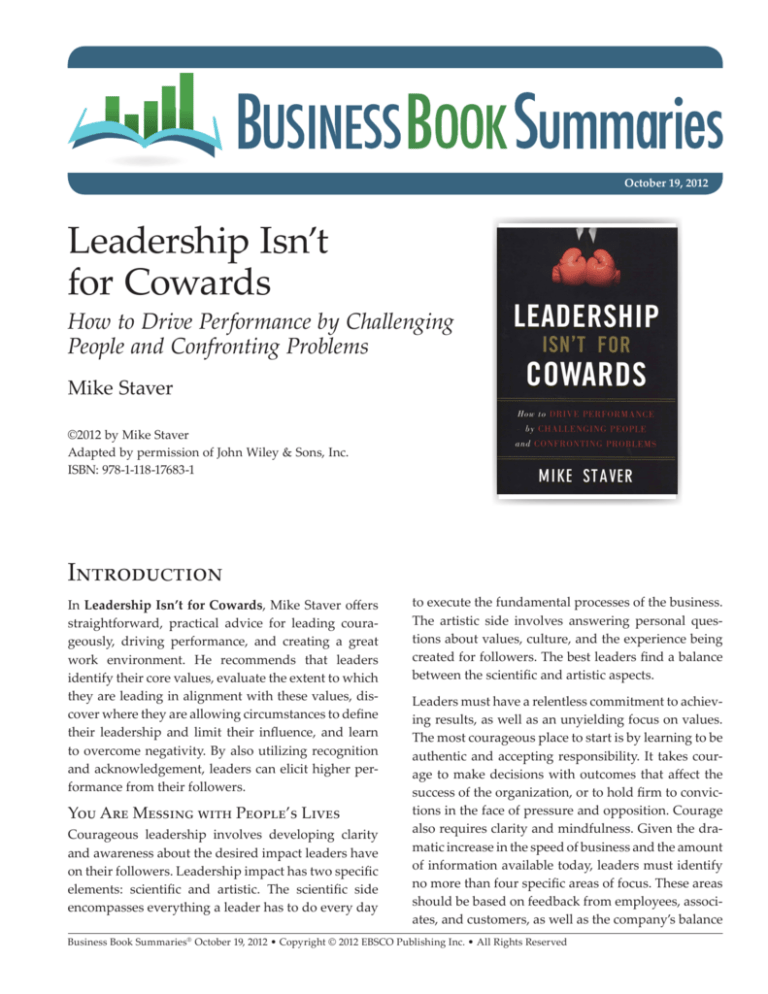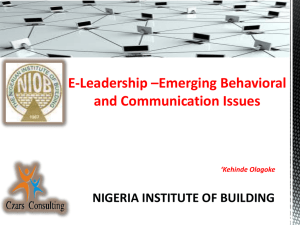
October 19, 2012
Leadership Isn’t
for Cowards
How to Drive Performance by Challenging
People and Confronting Problems
Mike Staver
©2012 by Mike Staver
Adapted by permission of John Wiley & Sons, Inc.
ISBN: 978-1-118-17683-1
Introduction
In Leadership Isn’t for Cowards, Mike Staver offers
straightforward, practical advice for leading courageously, driving performance, and creating a great
work environment. He recommends that leaders
identify their core values, evaluate the extent to which
they are leading in alignment with these values, discover where they are allowing circumstances to define
their leadership and limit their influence, and learn
to overcome negativity. By also utilizing recognition
and acknowledgement, leaders can elicit higher performance from their followers.
You Are Messing with People’s Lives
Courageous leadership involves developing clarity
and awareness about the desired impact leaders have
on their followers. Leadership impact has two specific
elements: scientific and artistic. The scientific side
encompasses everything a leader has to do every day
to execute the fundamental processes of the business.
The artistic side involves answering personal questions about values, culture, and the experience being
created for followers. The best leaders find a balance
between the scientific and artistic aspects.
Leaders must have a relentless commitment to achieving results, as well as an unyielding focus on values.
The most courageous place to start is by learning to be
authentic and accepting responsibility. It takes courage to make decisions with outcomes that affect the
success of the organization, or to hold firm to convictions in the face of pressure and opposition. Courage
also requires clarity and mindfulness. Given the dramatic increase in the speed of business and the amount
of information available today, leaders must identify
no more than four specific areas of focus. These areas
should be based on feedback from employees, associates, and customers, as well as the company’s balance
Business Book Summaries® October 19, 2012 • Copyright © 2012 EBSCO Publishing Inc. • All Rights Reserved
Leadership Isn’t for Cowards
sheet. It is not the success, but the sustainability of
success that makes an organization admirable.
Accept Your Circumstances
ATTACK is an acronym Staver uses to describe the
most important parts of courageous leadership. The
first A in ATTACK stands for Accepting Circumstances,
which means facing a situation exactly as it actually
is, recognizing leadership strengths and limitations,
and working effectively within the current reality. It
also entails understanding the difference between
constructive and destructive denial, upholding honesty, facing reality, and maintaining focus.
Courageous leadership begins with rigorous acceptance of the truth and the way that truth impacts the
performance of followers. Destructive denial is when a
person refuses to accept reality, and that refusal has
destructive consequences. Constructive denial is when
a person presses on in a way that inspires achievement against all odds.
Leaders must see what their followers cannot see and
push them forward in spite of reality. Courageous
leaders also openly accept the presence of obstacles,
challenges, and even tragedies, but deny their power
and refuse to succumb to them. Courageous leadership is grounded in the belief that accepting current
circumstances is not equal to surrendering to them.
Honesty is the best policy when it meets three criteria:
Mike Staver
Key Concepts
In Leadership Isn’t for Cowards, Mike Staver
uses the acronym ATTACK to demonstrate the
essential components of becoming a courageous
leader:
• Accept the Circumstances: Face the situation
as it actually is by recognizing leadership
strengths and limitations, and working effectively within the current reality.
• Take Action: Build a balance between being
ready and taking risks.
• Take Responsibility: Articulate and apply steps
to create a culture of followers who take ownership of their responsibility.
• Acknowledge Progress: Pay attention to the
progress that is being made.
• Commit to New Habits: Cultivate leadership
behaviors including accountability, communicating powerfully, and coaching.
• Kindle: Give new life to leadership, the performance of followers, and the way people
feel about their work.
g g g g
1. Factual accuracy.
2. Usefulness for the listener.
3. Constructive delivery.
Courageous communicators can effectively deliver
messages that are constructive, direct, firm, and
respectful; helping to improve performance; and promoting further development and advancement. Focus
is one of the biggest challenges for leaders; it takes
courage for them to be disciplined and to focus on the
things that will have the greatest impact.
Take Action
The first T in ATTACK stands for Take Action. This
refers to the skills of analysis, as well as being ready,
being present, and overcoming fear.
Information about the author and subject:
www.thestavergroup.com
Information about this book and other business titles:
www.wiley.com
Related summaries in the BBS Library:
The Twelve Absolutes of Leadership
By Gary Burnison
Mindful Leadership
The 9 Ways to Self-Awareness, Transforming
Yourself, and Inspiring Others
By Maria Gonzalez
The ability to analyze helps leaders solve problems,
make decisions, and keep their organizations on
Business Book Summaries® October 19, 2012 • Copyright © 2012 EBSCO Publishing Inc. • All Rights Reserved
Page 2
Leadership Isn’t for Cowards
Mike Staver
track. Courageous analysis requires the combination
with difficult circumstances. Personal responsibility
of facts and intuition, and leaders must merge their
creates opportunity, while blame creates paralysis.
scientific and artistic sides to perform comprehensive
Courageous leaders must eliminate excuse-making
analyses. The corporate world is moving faster than
and stop shifting blame from themselves and their
ever before, and waiting until everyone is completely
organizations. When a problem arises, the key is not
ready will quickly destroy opportunities. One of the
to fixate on who is responsible and why, but rather to
most courageous things leaders can do is to shift folown it, present a solution, and move on.
lowers from a waiting mindset
to an anticipating, action-based Acknowledging progress is much more than a pizza, a special
mindset. Driving followers into parking place, or a bonus. It is about being able to articulate how
action and encouraging involve- your followers’ progress matters to you.
ment and initiative is critical to
building high performance.
Leaders who demonstrate the ability to be clear and
People have a tendency to focus on the past and the
concise will create a model that followers can easily
future rather than the present moment. This can be the
emulate. The best leaders are tough without diminresult of worry, anticipation, regret, or hope. Couraishing anyone’s self-esteem or self-respect. They
geous leaders must commit to being both thoughtful
coach their followers to consider the intended and
and present in the moment. Action is the key to solvunintended consequences of their choices. It is very
ing problems, achieving goals, and enjoying the most
important that leaders clearly explain their expectasuccess. When time and energy is wasted on excusetions and reasoning, and work with their followers to
making and hesitation, both leaders and their teams
create the attitudes and mindsets necessary for sucsuffer. Hesitation and resistance to action do far more
cess. Attitudes always manifest themselves in choices
damage and destroy more opportunities than misand those choices drive behavior.
taken actions. Actions drive results.
Leaders are often charged with removing obstacles
from the paths of their followers. Staver refers to
Take Responsibility
obstacles as “pinch points.” A pinch point is anything
The second T in ATTACK stands for Take Responsibilthat slows or stops the flow of productivity. It can be
ity. Blame is the opposite of responsibility and is an
a process, person, policy, or program. Pinch points
energy-draining, counterproductive way of dealing
can be organizational or personal. Courageous leaders free their followers to openly and clearly identify
pinch points and suggest plans to relieve them.
About the Author
Mike Staver is CEO of the Staver Group
and provides keynote presentations, executive coaching, consulting, and workshops.
His clients have included Leading Real Estate
Companies of the World, Cisco Systems Inc.,
Amplifon USA, Med One Capital, Inc., UnionBanc Investment Services, FOCUS Brands,
U.S. Department of Defense, Allstate Financial
Services, National Association of REALTORS,
Mayo Clinic, and more. His work has appeared
in Bloomberg Businessweek, the Washington Post,
Fox News Channel, USA Today, and T+D magazine.
Acknowledge Progress
The second A in ATTACK stands for Acknowledge Progress. Leaders must pay attention to the progress their
followers are making, and strike a balance between
holding back recognition and over-recognizing.
Courageous leaders must have deep, clearly articulated, and meaningful goals. These goals not only
drive professional accomplishments but also deepen
personal development and leadership skills. Goals
should be concrete, clear, and actionable, and each
should result in one of the following:
1. Creating a new behavior.
2. Eliminating an undesirable behavior.
Business Book Summaries® October 19, 2012 • Copyright © 2012 EBSCO Publishing Inc. • All Rights Reserved
Page 3
Leadership Isn’t for Cowards
3. Changing an existing behavior.
It is important that leaders determine the desired
result and then work to align everyone’s behaviors with that result. There are leaders that do not
acknowledge progress at all, and there are others that
acknowledge everything, everywhere, even when it is
inappropriate. Neither behavior demonstrates courageous leadership.
A lack of acknowledgement can destroy future progress. Appropriate acknowledgement of progress
begins with full and complete focus on success in
the present moment. It is not qualified or diminished
in any way. Delaying all celebration until the goal is
completely accomplished can compromise momentum. Recognition and acknowledgement of progress
toward a goal can have an immediate impact on
momentum. It reinforces peoples’ desires to accomplish more so they can receive recognition.
Mike Staver
in a way that creates the most motivation, then it must
be delivered in a way that lands on target. Praise must
be delivered in a credible manner, and those receiving
it must sense that the acknowledgement comes from
an authentic place. It is impossible to drive a culture
of significance and purpose if the people, including
the leaders, are not experiencing acknowledgement
of their progress. Changing a culture is a monumental task and those at the top must feel that the vision
impacts them deeply and personally if they are to
maintain the energy necessary to succeed. Three
things are necessary for the acknowledgement of
progress to drive performance:
1. Honesty
2. Trust
3. Consistency
Leaders must know what kind of acknowledgement
to give, as well as when and how to give it. The first
For some leaders, acknowledging progress finds its
step in this process is to make the acknowledgement
challenge in the context of the acknowledgement.
of progress as close to the actual event as possible.
Group recognition is harder for some leaders, while
The closer to the event, the more impact it will have.
others struggle with the one-on-one, face-to-face eleAlso, it is helpful to point out as much specific data
ments of recognition. Both are important forms of
and information as possible to support the acknowlacknowledgement and courageous leaders must work
edgement. Whenever possible, the acknowledgement
to perfect them. Having a sincere and honest tone is
should be done face to face, and it should always
the key to making the acknowledgement effective.
be sincere and authentic. Leaders must never use
acknowledgement or recogniWhile acknowledgment of progress is certainly an important tion as a way to make bad news
and vital part of driving performance, it is not all there is to it. better or as a way to deliver critiPeople will not achieve just because you encourage and motivate cism. Also, they must never use
them. Somebody must drive performance and refuse to accept acknowledgement or recognition
as compensation for a mistake on
anything but success.
the part of management.
When leaders praise and encourage their employees
Courageous leaders must not be willing to settle for
for everything, their acknowledgement loses its effecmediocrity; they must make it clear that excellence
tiveness. This can come in the form of gushing, fake
and achievement are essential. A relentless commitrecognition, or failure to recognize the right people
ment to achievement at the highest level is a bold and
for the right reasons. Gushers are so “syrupy” that
courageous way to ensure that acknowledgement is
their credibility is called into question. As much as
truly meaningful. It is the responsibility of leadership
people are demotivated by leaders who under-recto lay out expected results in the most effective way
ognize, there is an equal demotivation factor when
possible. Followers deserve clarity and frank, diploleaders recognize so much and with such flair that it
matic communication about expectations. Excellence
is not trustworthy or meaningful.
happens because every person in the organization has
Recognition is useful because of its quality, not its
absolute clarity about what the expectations are, how
quantity. If acknowledgement is going to be received
they are measured, and the specific part each person
Business Book Summaries® October 19, 2012 • Copyright © 2012 EBSCO Publishing Inc. • All Rights Reserved
Page 4
Leadership Isn’t for Cowards
Mike Staver
needs to play to achieve them.
There are four reasons why anyone in an organization
will fail:
1. Ignorance
2. Refusal
3. Obstacles
4. Capability
If the problem is ignorance, then leaders must quickly
and efficiently provide the training their followers need to accomplish the job. Refusal to do the job
cannot be tolerated. Obstacles need to be removed. If
capability is the problem, jobs must be redesigned, or
reassigned to another person. In all cases, excellence
should be the mantra. Compromise is not an option,
and effort is not enough.
Commit to New Habits
be problems. Problems are a necessary part of leadership because they strengthen a team’s ability to
persevere. A leader’s job is not to eliminate problems,
but to solve them. All problems and conflicts can be
described as situations where something is desired,
and something else is blocking the way.
Problems and conflicts are easier to manage if there is
a process to follow; however, battles must be chosen
carefully. Once a leader decides to act on a problem,
his or her first step must be to determine what each
party needs or wants from the solution. The problem
can then be solved by evaluating possible solutions
through two filters: “Is it feasible?” and “Is it practical?” Next, the leader must act on the proposed
solution, follow up, and evaluate the outcome.
The second habit, communicating powerfully, has
two essential components:
1. Communicating clearly
The C in ATTACK stands for Commit to New Habits. To
2. Communicating tactfully
have a significant impact on the behavior of followers, leaders must commit to habits
If you are going to lead courageously, you must create a highly
of accountability, communicating
accountable culture. Hold your people accountable. Not just
powerfully, and coaching.
sometimes. Not once in a while. All the time. Commit to mak-
Accountability is different from
hovering; it focuses on the big ing it a habit.
picture by making observations,
asking good questions, and encouraging course correction. Leaders must identify desired outcomes and
develop a strategy. In return, followers must commit
to the results. Accountability, in most cases, is about
making sure the intended results are achieved. The
most effective way to approach accountability is to be
clear about results, have relentless focus on achieving
them, and still allow maximum flexibility.
Clarity means saying things in a way that eliminates doubt. Clarity pushed to the extreme becomes
bluntness, which is why tact must also be used. Effective communication entails making a point without
offending others. To balance tact and clarity, leaders
must:
• Understand the message in advance of communicating it.
There are three habits that are particularly important
when committing to accountability:
• Know the audience.
1. Solving problems independently.
Leaders who struggle the most do so because they
lack skills in independent problem solving, communication, and getting along with others. Leaders
that get into the most trouble struggle with playing
well with others. They can improve the way they act
around others by:
2. Communicating powerfully.
3. Playing well with others.
Leaders need to commit to all three, and encourage
their direct reports to do the same.
The first habit, solving problems independently,
requires acceptance of the fact that there will always
• Deliver the message succinctly without harshness.
• Being actively interested in others.
• Modeling behaviors that are considerate of other
Business Book Summaries® October 19, 2012 • Copyright © 2012 EBSCO Publishing Inc. • All Rights Reserved
Page 5
Leadership Isn’t for Cowards
people and departments.
• Refusing to tolerate the mistreatment of others.
While most companies regularly talk about innovation, differentiation, and gaining a competitive edge,
many people fear actively exploring and doing different things because it requires a certain amount of risk.
Courageous leaders must be creative, challenge their
followers to constantly think differently, and move
away from their comfort zone. Doing different things
requires understanding the needs of all constituencies,
including customers, employees, and the community.
If leaders provide solid ground by being tolerant of
unconventional answers, occasional disruptions, or
creative tangents, their followers will thrive.
The third essential habit is the habit of coaching.
Coaching provides a venue for accountability, development of good habits, and brainstorming ways to do
different things. To drive performance, leaders must
spend one-on-one time with their followers through
meaningful,
performance-based
conversations.
Effective leaders must be engaging and compelling
coaches. The goal of coaching is to move people from
what they currently do to what they are capable of
doing.
Leaders who commit to the habit of coaching must
understand that they cannot control or change other
people. The job of the coach is not to change people,
but to illuminate possibilities and suggest things that
they have not thought of on their own. Those being
coached must be committed to change in order to be
successful. One of the most important parts of coaching is establishing context. Those being coached need
to understand the process and the purpose.
Coaching is a process of asking questions and helping people explore, grow, and develop, and having a
defined coaching process is very important. Leaders
can make coaching sessions more effective by:
Mike Staver
Kindle
The K in ATTACK stands for Kindle. Courageous leaders must give new life to their own leadership, their
followers’ performance, and the way everyone feels
about their work. Kindling means creating new life,
inspiring or building passion, and starting small and
building up.
People tend to hold some energy in reserve because
they may need it for something really important.
Leaders who can release that energy will move the
group to higher levels of achievement. Energy is the
most critical part of driving results, and that energy
starts with leaders. Failure to kindle followers in ways
that are unique and based on their needs will leave
valuable energy and intensity on the table.
Noticing others and being self-aware are necessary
steps in the process of kindling followers. Effective
leaders do not just observe what is happening, but
care about the effect it is having on people. Noticing
others matters because it makes people feel significant.
Courageous leaders remove mental clutter and leave
space for self-awareness and noticing things, like how
their style is received by their followers and whether
or not they are effectively inspiring and breathing life
into the organization.
Now What?
Energy, when invested wisely, can yield significant
benefits. By cutting out the excess and focusing on
what is needed, leaders can choose which strategies
to apply in order to have the maximum impact. Small
changes can have a huge impact over time, and persistence is an important trait of the most courageous
leaders.
g g g g
• Always remaining curious and interested in what
those being coached have to say.
Features of the Book
• Remaining neutral and nonjudgmental.
Estimated Reading Time: 3.5 hours, 213 Pages
• Pointing out the strengths of the people they are
coaching, and helping them build on their ideas.
In Leadership Isn’t for Cowards, Mike Staver presents strategies and methods for solving the problems
that limit leadership performance. Using the word
ATTACK as an acronym, he develops a clear plan for
• Being free from bias, but grounded in belief.
Business Book Summaries® October 19, 2012 • Copyright © 2012 EBSCO Publishing Inc. • All Rights Reserved
Page 6
Leadership Isn’t for Cowards
Mike Staver
leading with courage. Each chapter ends with a set
of questions designed to guide self-evaluation and
initiate action steps, as well as a QR code and web
address to access downloadable worksheets. Leaders
at all stages of career development could benefit from
Staver’s ideas and recommendations. The book is best
read cover-to-cover.
Section 5: Acknowledge Progress
Contents
Chapter 24: Are You about Effort or Achievement?
Acknowledgements
Section 6: Commit to New Habits
Section 1: You Are Messing With People’s Lives
Chapter 25: Just How Much Accountability Can One
Person Stand?
Chapter 1: Do You Know What You Are Doing?
Chapter 2: How Much of an Impact Are You Really
Having?
Chapter 20: How Goal-Driven Are You?
Chapter 21: Are You Too Harsh?
Chapter 22: Are You an Over-Recognizer?
Chapter 23: What, When, and How?
Chapter 26: Do You Need to Be Committed?
Chapter 27: Just How Different Are You?
Chapter 3: Are You a Coward?
Chapter 28: What’s That Weight on Your Back?
Chapter 4: Is Culture Overrated?
Section 7: Kindle
Attack
Chapter 29: Is It Really Just an e-Reader?
Section 2: Accept Your Circumstances
Chapter 30: How Are You Feeling?
Chapter 5: How Great is Denial?
Chapter 31: Did You Seriously Think That Would
Work?
Chapter 6: What Are You Pretending Not to Know?
Chapter 7: Are You Honest?
Chapter 8: What is Real?
Chapter 9: Where is Your Focus?
Section 3: Take Action
Chapter 10: Are You Good at Analyzing?
Chapter 11: When Are You Ready?
Chapter 12: How Present Are You?
Chapter 32: Do You Ever Notice?
Chapter 33: Ever Given Birth?
Section 8: Now What?
Chapter 34: Do You Want To?
Chapter 35: Are You Willing?
Chapter 36: Can You Please Just Get On With It?
Index
Chapter 13: Do You Remember a Time when You Hesitated and Lost?
Chapter 14: Are You In, or Aren’t You?
Section 4: Take Responsibility
Chapter 15: Want to Responsibly Scare Some People?
Chapter 16: How Much Blame Can You Take?
Chapter 17: What Difference Do You Make?
Chapter 18: What Kinds of Responsibility Are You
Taking?
Chapter 19: Are You Truly Free?
Business Book Summaries® October 19, 2012 • Copyright © 2012 EBSCO Publishing Inc. • All Rights Reserved
Page 7
Leadership Isn’t for Cowards
Mike Staver
A Note to Our Readers
We at BBS encourage our readers to purchase the business books we summarize.
BBS Summaries are intended as a service to busy professionals, as we recommend only those books
that are worth your time to read in their entirety. We apply stringent criteria in selecting only the best
business books, and in that selection process, strive to help you make informed book-purchasing decisions.
Click to Buy This Book
This book is available at bookstores and online booksellers.
Business Book Summaries® is a service of EBSCO Publishing, Inc.
For more information about BBS, to subscribe to BBS,
or to provide us feedback, visit our Web site.
www.ebscohost.com
EBSCO Publishing Inc.
10 Estes Street
Ipswich, MA 01938 USA
Copyright of Business Book Summaries, Business Book Review, BusinessSummaries and BizSum is property of EBSCO Publishing
Inc. and its content may not be copied or emailed to multiple sites or posted to a listserv without the copyright holder’s
express written permission. However, users may print, download or email articles for individual use.
Business Book Summaries® October 19, 2012 • Copyright © 2012 EBSCO Publishing Inc. • All Rights Reserved
Page 8
Copyright of Leadership Isn't for Cowards is the property of Great Neck Publishing and its content may not be
copied or emailed to multiple sites or posted to a listserv without the copyright holder's express written
permission. However, users may print, download, or email articles for individual use.









